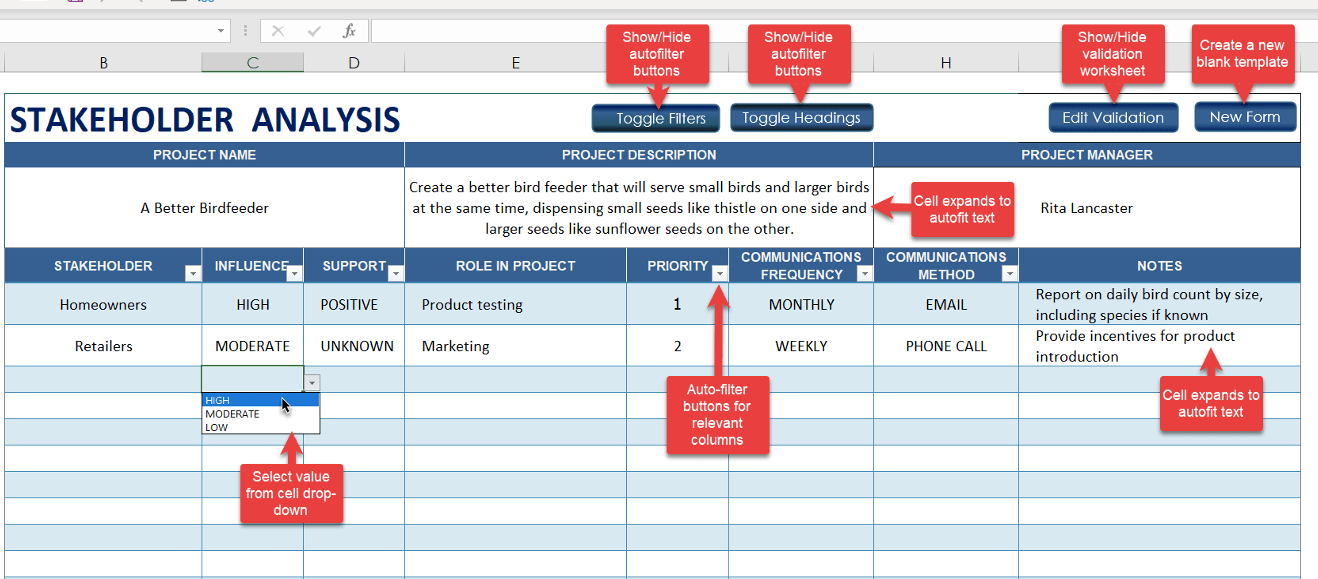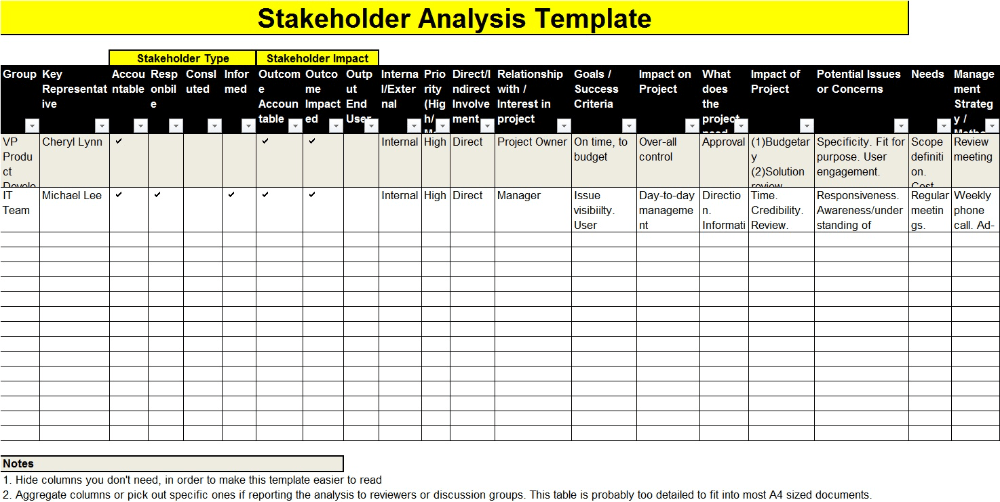Understanding the Stakeholder Matrix
A stakeholder matrix, also known as a power-interest grid, maps stakeholders based on their level of interest in the project and their power to influence its outcome. This tool helps project managers identify which stakeholders need more attention and engagement throughout the project lifecycle.
The matrix typically consists of a two-dimensional grid with four quadrants. The vertical axis represents the level of power or influence a stakeholder has, while the horizontal axis shows their level of interest. Stakeholders fall into one of the four quadrants:
- High Power, High Interest: These stakeholders are key players. They have significant influence and a strong interest in the project’s success. Engage them closely and keep them satisfied.
- High Power, Low Interest: These stakeholders possess high influence but have limited interest. Keep them satisfied without overwhelming them with unnecessary details.
- Low Power, High Interest: These stakeholders have a strong interest but limited influence. Keep them informed and involved to ensure their support.
- Low Power, Low Interest: These stakeholders have minimal impact and interest. Monitor them with minimal effort.

Creating a Stakeholder Matrix Template
To create this template, follow these steps:
- Identify Stakeholders: List all individuals, groups, and organizations with a vested interest in the project. This includes internal stakeholders (e.g., team members, managers) and external stakeholders (e.g., clients, suppliers, regulatory bodies).
- Assess Power and Interest: Evaluate each stakeholder’s level of power and interest. Use a scale (e.g., 1 to 5) to rate their influence and interest, with 1 being the lowest and 5 being the highest.
- Plot Stakeholders on the Matrix: Place each stakeholder on the matrix based on their power and interest ratings. This visual representation helps in understanding their position and the level of engagement required.
- Develop Engagement Strategies: Based on the stakeholders’ positions in the matrix, devise strategies to manage their expectations and communication needs. This ensures that key players remain engaged and supportive while keeping other stakeholders appropriately informed.
Related Article: 6 Steps To Build Project Resource Planning Template- PMITOOLS
Benefits in Project Management
The template plays a pivotal role in project management by providing several key benefits:
Enhancing Communication
Effective communication is vital in project management. The stakeholder matrix helps project managers identify the communication needs of different stakeholders. By tailoring communication strategies based on stakeholders’ positions in the matrix, project managers can ensure that key players receive the necessary information and that their concerns are addressed promptly.
Facilitating Stakeholder Engagement
Engaging stakeholders throughout the project lifecycle boosts support and reduces resistance. The matrix highlights stakeholders who require more attention and engagement, ensuring that their needs and expectations align with the project objectives. This proactive approach minimizes potential conflicts and fosters a collaborative project environment.
Related Article: 6 Tips To Design Project Status Report Template – PMITOOLS
Prioritizing Resource Allocation
Resource allocation becomes more efficient with a clear understanding of stakeholder influence and interest. The stakeholder matrix helps project managers prioritize resources and efforts towards stakeholders who can significantly impact the project’s success. This focused approach optimizes resource utilization and enhances project outcomes.
Mitigating Risks
Identifying and managing risks early in the project lifecycle is crucial. Stakeholders can introduce risks or provide insights into potential issues. The stakeholder matrix allows project managers to recognize stakeholders who may pose risks and develop mitigation strategies accordingly. By addressing these risks proactively, project managers can prevent potential setbacks and ensure smoother project execution.
Building Stronger Relationships
Establishing strong relationships with stakeholders leads to a more collaborative and supportive project environment. The stakeholder matrix fosters these relationships by highlighting stakeholders’ interests and influence. Understanding and addressing stakeholders’ concerns builds trust and credibility, enhancing the project’s overall success.

Practical Application of the Stakeholder Matrix Template
To illustrate the practical application of this template, consider a software development project. The project team needs to identify and manage various stakeholders to ensure successful project delivery.
Step 1: Identify Stakeholders
In this example, stakeholders include the project sponsor, development team, QA team, end-users, regulatory bodies, and external vendors.
Step 2: Assess Power and Interest
Each stakeholder’s power and interest are assessed as follows:
- Project Sponsor: High Power, High Interest
- Development Team: Medium Power, High Interest
- QA Team: Medium Power, Medium Interest
- End-Users: Low Power, High Interest
- Regulatory Bodies: High Power, Low Interest
- External Vendors: Low Power, Low Interest
Related Article: 8 Components Of Employee Management System- PMITOOLS
Step 3: Plot Stakeholders on the Matrix
Stakeholders are placed on the matrix based on their power and interest ratings. This visual representation aids in understanding their positions and the required engagement level.
Step 4: Develop Engagement Strategies
For this project:
- Project Sponsor: Engage closely through regular updates and involve in key decisions.
- Development Team: Keep informed and involved in daily progress and challenges.
- QA Team: Maintain regular communication to ensure quality standards.
- End-Users: Conduct regular feedback sessions to incorporate their needs and expectations.
- Regulatory Bodies: Ensure compliance and provide necessary information without overwhelming them.
- External Vendors: Monitor performance and maintain periodic check-ins.
Conclusion
The Stakeholder Matrix Template stands as an indispensable tool in project management, offering a structured approach to stakeholder identification, assessment, and engagement. By understanding stakeholders’ influence and interest, project managers can develop targeted strategies to communicate effectively, engage stakeholders, prioritize resources, mitigate risks, and build strong relationships.
Incorporating a stakeholder matrix into project management practices enhances the likelihood of project success. This tool not only streamlines stakeholder management but also fosters a collaborative and supportive project environment. As projects become more complex and involve diverse stakeholders, this template will remain a crucial asset for project managers seeking to deliver successful outcomes.
Related Article: Stakeholder analysis – Wikipedia
This article highlights the significance of the stakeholder matrix template, emphasizing its role in effective project management. By integrating this tool into their practices, project managers can navigate the complexities of stakeholder engagement and drive their projects towards success.


